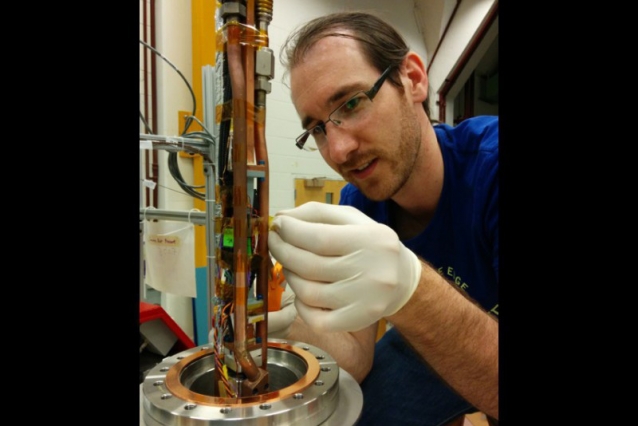Apr 22 2015
 A new tabletop particle detector (shown here) is able to identify single electrons in a radioactive gas. (Image courtesy of the researchers)
A new tabletop particle detector (shown here) is able to identify single electrons in a radioactive gas. (Image courtesy of the researchers)
MIT scientists have created a new particle detector that identifies individual electrons in a radioactive gas. When the gas produces electrons after decay, this new tabletop detector traps them in a magnetic bottle, using a magnet.
The weak signals produced by the electrons are collected by a radio antenna in order to precisely map the activity of the electrons over several milliseconds.
The MIT team along with researchers at Pacific Northwest National Laboratory, the University of Washington, the University of California at Santa Barbara (UCSB) and elsewhere recorded over 100,000 single electrons’ activities in krypton gas.
Most of the electrons observed followed a characteristic pattern. With the decay of the radioactive krypton gas, the electrons are emitted such that they vibrate at a baseline frequency before fading out gradually. The frequency is increased when an electron hits the atom of radioactive gas. With the forward and backward movement of atoms within the detector, the energy tends to increase in a step-like form.
We can literally image the frequency of the electron, and we see this electron suddenly pop into our radio antenna. Over time, the frequency changes, and actually chirps up. So these electrons are chirping in radio waves.
Joe Formaggio - Associate Professor of Physics at MIT
Formaggio stated that the findings published in Physical Review Letters could be potentially used for measuring the mass of a neutrino.
Neutrinos are mysterious elementary particles that enter every cell of the body. These ghostly particles are extremely difficult to be identified as they do not interact with normal substances. Although scientists have set theoretical limits on neutrino mass, the researchers still could not detect them precisely.
“We have [the mass] cornered, but haven’t measured it yet. The name of the game is to measure the energy of an electron — that’s your signature that tells you about the neutrino, Formaggio said. ”
Following the decay of a radioactive atom such as tritium, a helium isotope is formed thereby releasing a neutrino and an electron. The amount of energy of all released particles sums up to the energy of the parent electron. Therefore, the measurement of electron energy can illuminate the energy and the mass of the neutrino.
Scientists believe that the key to obtain precise measurement is by using tritium, a radioactive isotope of hydrogen. This is because tritium decays at a rate that enables the scientists to observe its electron byproducts.
As a part of Karlsruhe Tritium Neutrino (KATRIN) Experiment, researchers in Karlsruhe, Germany made use of a massive spectrometer to measure tritium electrons. Electrons that are produced from the tritium decay pass via the spectrometer which filter them based on the different energy levels. The experiment is under way, and the researchers hope to achieve measurements of single electrons.
“In KATRIN, the electrons are detected in a silicon detector, which means the electrons smash into the crystal, and a lot of random things happen, essentially destroying the electrons. We still want to measure the energy of electrons, but we do it in a nondestructive way, ” said Daniel Furse, a graduate student in physics, and a co-author on the paper.
The size, however, is an added advantage to the group’s setup. The detector can be compactly placed on a tabletop, and the electrons are detected in a space that is smaller than a postage stamp. KATRIN’s spectrometer, in contrast, is huge when delivered to Karlsruhe.
Furse and Formaggio’s detector of “Project 8” experiment is designed based on the cyclotron radiation principle where the radio waves are emitted in a magnetic field by charged particles such as electrons. It was observed that this radiation is emitted by the electrons at frequency similar to that of military radio communications.
“It’s the same frequency that the military uses — 26 gigahertz. And it turns out the baseline frequency changes very slightly if the electron has energy. So we said, Why not look at the radiation [electrons] emit directly?," Formaggio said.
Formaggio and former postdoc Benjamin Monreal, now an assistant professor of physics at UCSB, stated that it is possible to trap the electrons as they are emitted from a decaying radioactive gas to measure their magnetic field energy upon tuning the baseline frequency.
“If you could measure the frequency of this radio signal, you could measure the energy potentially much more accurately than you can with any other method. The problem is, you’re looking at this really weak signal over a very short amount of time, and it’s tough to see, which is why no one has ever done it before,” Furse said.
The researchers took nearly five years to design an accurate detector. Upon switching the detector on, they were able to record single electrons in 100ms.
“Our software was so slow at processing things that we could tell funny things were happening because, all of a sudden, our file size became larger, as these things started appearing,” Formaggio said.
He further added that the measurement accuracy of krypton gas has pushed the team forward to work on tritium to measure the neutrino mass. This goal can be achieved in the next year or a year after.
Steven Elliott, a technical staff member at Los Alamos National Laboratory, said that the group’s new detector “represents a very significant result.” He added that the multiple improvements are required to develop a huge cell to store tritium in large quantities.
The research was supported by the National Science Foundation and the Department of Energy.